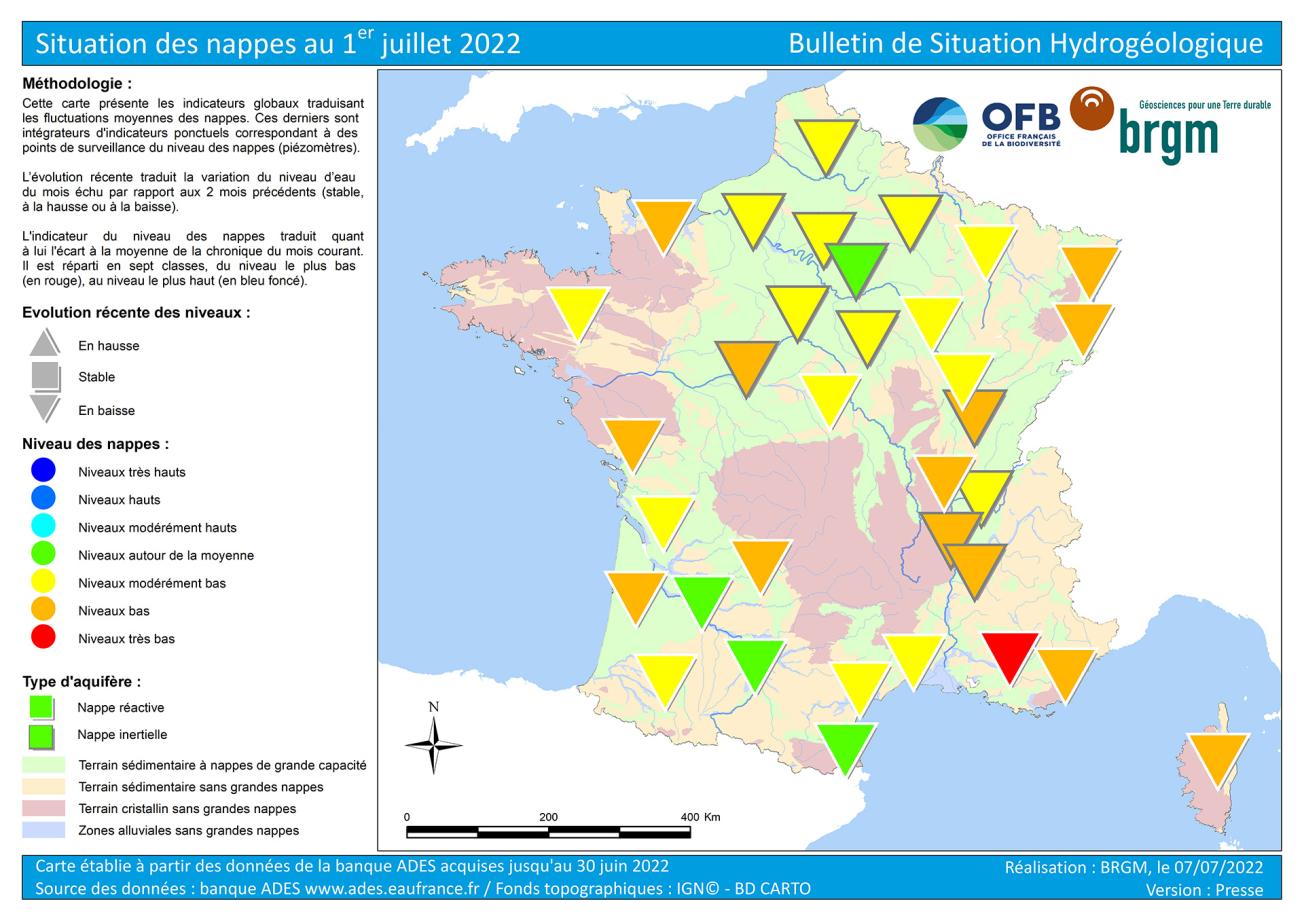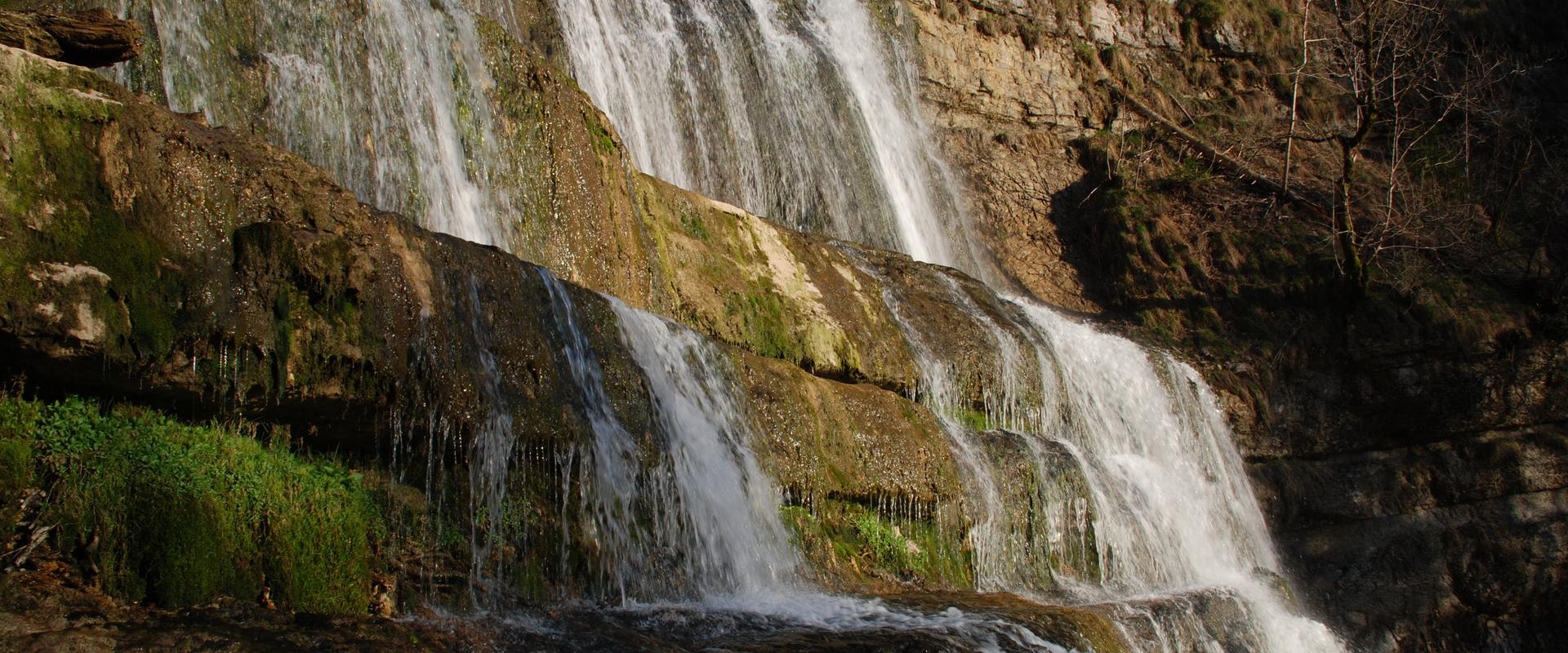
Map of water table levels in France on 1 July 2022.
© BRGM
Hydrogeological situation on 1 July 2022
In June, the depletion continued and all the water table levels were decreasing. This is quite normal in summer. The heavy rainfall in June essentially moistened the soil and was beneficial for vegetation, but it did not filter down into the aquifers, except in a few local areas.
Consequently, the state of the aquifers continued to deteriorate during June, except in the Jurassic limestone aquifers of Charente and southern Vendée. Groundwater levels were generally below or at their average levels for June. A substantial number of reservoirs remained at moderately-low to low levels. The situation is particularly worrying in several areas that have very low groundwater levels, notably in the centre-west region (Charente, Poitou, Brenne, Touraine) and in the south-east (Bas-Dauphiné, Provence and Côte d'Azur).
In July, the levels of inertial aquifers are expected to continue their downward trend. The situation in these aquifers is not expected to change much in the next few weeks, except in areas where withdrawals are particularly intensive. As regards reactive water tables, the trends and developments will depend primarily on effective local rainfall, the degree of evapotranspiration and the demand on water supplies. The situation needs to be closely monitored all around the country and notably in all the reactive aquifers as well as in those inertial aquifers which already had low water levels in June, or in areas where withdrawals are particularly intensive.
Groundwater trends
The aquifers across the entire country experienced a winter recharge that was well below average in 2021-2022. This recharge period ended two to three months early, between January and March, due to the lack of significant rainfall. Consequently, the aquifers began to empty and there was a downward trend in groundwater levels throughout the spring.
In June, the depletion of the aquifers continued and the levels remained low. This is normal for the period. The infiltration of rain water moistened the soil and was beneficial for vegetation. However, this was insufficient to recharge the aquifers.
Following the heavy rainfall in June, high levels were observed locally. But these high levels were temporary and soon stabilised, and even dropped below average levels in certain areas, where the rainfall was insufficient to compensate for the depletion of the aquifers. The effective rainfall during the month, which resulted in less demand on water supplies (mainly as regards irrigation), had a positive effect in a few areas with reactive aquifers. Consequently, the depletion rate slowed down in the aquifers of the Armorican massif basement in Ille-et-Vilaine and Finistère, as well as in the Jurassic limestone aquifers in the Vendée and southern Berry regions.
Situation in relation to the June averages
In June 2022, levels were quite poor, being either below or well below monthly norms. This situation is due to two main reasons: the very low recharge in the autumn and winter of 2021-2022 and the particularly dry spring. From February onwards, the aquifer levels dropped constantly. Consequently, the situation in the aquifers gradually deteriorated from February onwards, except in a few areas that benefited from sufficient effective rainfall during the spring.
As regards the inertial aquifers in the north of France and in the Rhône-Saône corridor, the gradual deterioration observed since March-April became more acute in June. These decreasing levels may be further exacerbated by strong demand on groundwater resources. The levels were generally moderately low in the Paris Basin and low in the Rhône-Saône corridor.
As regards the reactive aquifers, the levels were generally below monthly norms. Generally speaking, the situation continued to deteriorate, particularly in areas that did not receive enough rainfall to produce a recharge or in areas subject to significant groundwater withdrawals. The situation has only improved in the Jurassic limestone aquifers of Charente and southern Vendée, due to the contribution of rainfall and thus the need for fewer withdrawals for irrigation.
The situation was quite positive in several aquifers, which had approximately normal levels compared to those recorded in June in previous years:
- The levels of the aquifers in the tertiary formations from the Brie to the Tardenois region, which are not very sensitive to a lack of effective rainfall, remained close to normal;
- The alluvial aquifers of the Garonne and Dordogne rivers and their main tributaries benefited from several recharge periods during the spring. Their levels were close to monthly norms;
- The alluvial and Pliocene aquifers of the Languedoc coast and Roussillon benefited from effective rainfall in March and April and their levels were comparable to normal.
A less positive situation was observed in several aquifers, whose levels were low (or even very low, in some areas) compared to June averages:
- The levels in the Jurassic limestone aquifers of the Charente, Poitou and Brenne were low, due to a lack of rainfall during the winter and spring, although the situation improved in certain local areas in June;
- The levels in the chalk aquifers of the Touraine region were low, since the recharge period started late and did not last long;
- Water levels were low in the inertial pliocene-quaternary gravel aquifer of Burgundy-Franche-Comté. This is a legacy of several successive poor recharge periods;
- The alluvial aquifer of the Alsace plain, whose levels were moderately low to very low;
- The situation in the inertial aquifers of the fluvio-glacial corridors along the mid-section of the Rhône has progressively deteriorated. Here, the levels varied from near normal to very low;
- The levels in the Miocene molasse aquifer in the Bas-Dauphiné remained critical, with generally low levels. This is also linked to the gradual decrease in levels over several years. Very low levels were recorded in the Valence plain and in the hills of the north Drôme.
The levels in the alluvial aquifers and in the complex formations of Provence and the Côte d'Azur are still a concern. The levels remained low to very low, essentially due to insufficient recharges in 2020-2021 and 2021-2022, as well as a fairly severe low-water period in the summer of 2021.
Forecasts
The seasonal forecasts of Météo-France predict drier than normal conditions across two thirds of the south of France over the next 3 months. No dominant scenario has been forecast for the north of France. Temperatures are expected to be higher than normal across the whole country. However, episodes of heavy rainfall could occur from time to time.
In July, we expect the depletion of the aquifers to continue across the whole country. The lack of rainfall forecast by MétéoFrance could exacerbate this downward trend. If there is not sufficient rainfall (resulting in dry soils and increased demand on water supplies), the situation may continue to deteriorate. However, the rain that fell at the end of June should reduce the need for irrigation and thus relieve the pressure on water resources, notably in areas that received the most rainfall.
As it stands, unless there are truly exceptional rainfall events, no recharge episodes are expected in the inertial aquifers, so no improvement is likely before the autumn. The situation is expected to gradually deteriorate, more or less rapidly depending on the volumes of groundwater withdrawn. The situation could become worrying in the inertial aquifers in the Rhône-Saône corridor.
As regards reactive aquifers, the trends and developments will depend primarily on effective local rainfall and the demand on water supplies. If there is insufficient rainfall, levels will remain low and the situation will continue to deteriorate rapidly. In this case, the levels in reactive aquifers could reach low to very low levels across a large part of the country. However, significant rainfall events could result in brief recharges, which would help maintain groundwater levels and possibly even lead to increases, here and there. In this case, the situation might improve in certain areas, although above normal levels would still not be reached in the aquifers that have extremely low levels.
The situation needs to be closely monitored across all the country's aquifers, notably in reactive aquifers and in inertial aquifers that had low water levels in June, as well as in areas where withdrawals are particularly intensive.
Hydrological Status Report
The national hydrological status report consists of a set of maps with corresponding comments that show the monthly evolution of water resources. It describes the quantitative situation of aquatic environments (effective rainfall, river discharge, groundwater table levels, reservoir-dam filling status) and provides summary information on Prefectoral Orders issued to limit water use during the low-water period.
Press contact








